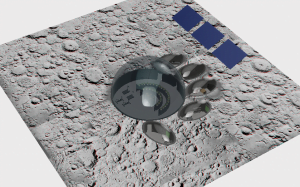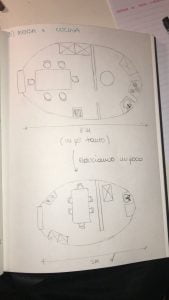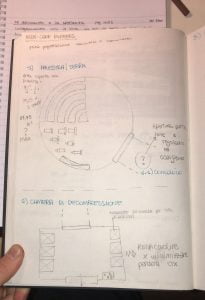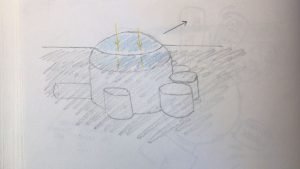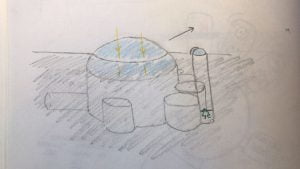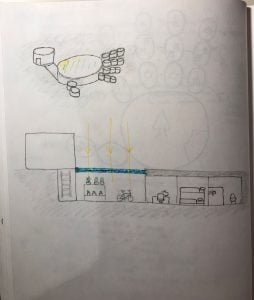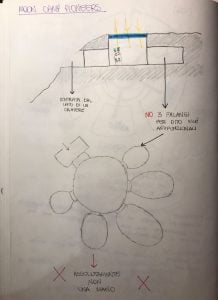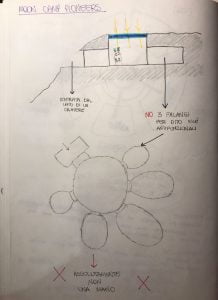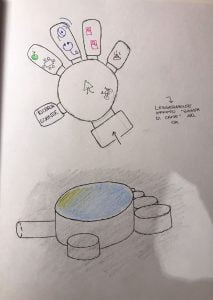Moon Camp Pioneers Gallery 2020-2021
In Moon Camp Pioneers each team’s mission is to 3D design a complete Moon Camp using Fusion 360. They also have to explain how they will use local resources, protect astronauts from the dangerous of space and describe the living and working facilities.
Team: HuMoon
Liceo scientifico A. Volta Milano Italy 18, 19
External viewer for 3d project
|
Project description
Our Moon Camp will be an outpost for further space exploration to widen the human knowledge of the universe. We think it essential for this project to highlight the fact that we are humans. We come from earth, but we won’t stop there. The Moon is the first place other than our planet that we will inhabit, therefore the planimetry of our base will resemble a human hand. It will literally be our print on the Moon. Thanks to its position our base will be sustainable, using sun power and local resources, such as ice from craters and regolith, to allow the astronauts’ continuous permanence on the base for. The primary goal of our camp will be to discover which resources the Moon has to offer, to explore our solar system and life in a hostile environment. Thanks to natural lighting coming from the roof, the presence of plants, fish, water and group activities, life in our camp will be enjoyable; in the long term this will allow us to open visits to ordinary people (space tourism) and maybe one day to make our satellite a space station for outer space traveling. |
|||
|
Where do you want to build your Moon Camp?
Our Moon Camp will be located in the South Pole, under the Shackleton Crater. In this region of the Moon, sunlight arrives almost all time long, therefore we could use solar energy as our main source of power. Thanks to constant sun exposure temperatures don’t experience frequent drastic changes. Water has been found on the Moon near the poles, so placing our camp there won’t make it too hard for us to reach for it. We will build our base under the surface in order to have protection from meteors and radiation on a significant portion of our structures, but the roofs will be cupolas filled with water emerging from the soil, to have natural lighting. How do you plan to build your Moon Camp? Describe the techniques and materials you would use.
Our Moon Camp will be set up by robots and a 3D printer and the astronauts will be sent there only once it is completed. At first robots will dig into the Shackleton Crater, then they will place aluminium walls and floors, a layer of hydrogenated BNNTs which NASA is studying to protect from neutron radiation and, as soon as algae will grow, we will place a layer of SEAgel as thermal insulation. Walls and floors will be coloured of a dark color to reduce the Albedo effect and heat them up a little. The base will be made up of different modules so that it will be easier to assemble them. In case we want to expand the hand print module can be reproduced and each hand will have a specific purpose (one hand for dormitory, one for labs etc.) Then the 3D printer will use dug regolith to create most of the furniture (which will be empty inside to reduce their weight) to use local resources instead of bringing too much from earth. The roofs will be pools shaped as cupolas made of a 20 cm layer of polyethylene which can be darkened and filled with 2 meters of water. This will protect our base from radiation and meteors while still allowing natural lighting. The whole base will be domotized and controllable from the earth (such as power consumption, air tite doors, air quality etc.). The environment on the Moon is very dangerous for the astronauts. Explain how your Moon Camp will protect them.
Our Moon Camp will have different methods to protect the astronauts from the hostile environment of the Moon. First of all, it will be built almost entirely underground. This will provide sufficient protection from meteors and radiation. The roofs will be cupolas made with a 20 cm layer of polyethylene and filled with 2 meters of water. The cupola is a type of structure that distributes the weight of the pool to the ground. Water will be essential to protect from radiation as well as polyethylene, which is also resistant to meteors. This type of roof can be darkened to block sunlight when needed to make artificial night which will help plant growth, astronauts’ sleep cycle and mood. Exercise will be compulsory a few hours a day and group activities will be organized periodically during leisure time to cheer up the crew. Explain how your Moon Camp will provide the astronauts with:
|
|||
|
Water
|
Food
|
Electricity
|
Air
|
|
We will extract ice from craters by digging the lunar soil. We will then melt the ice and take it to the base using a system of underground pumps and pipes, creating a route of tubes which go up and down. When going down water will flow thanks to gravity, once it has almost run out of motion, a pump system, powered by solar panels on the surface, will contract and reduce the tube’s diameter. This will allow water to flow back up into the next curve. Heat from the panels will also keep the water liquid. Once reached the base, water will fill the roof-pools and it will be stored in proper containers and used carefully for the base’s needs. We will water our crops through drip irrigation and we will have a recycling plant like the one on the ISS. |
Our Moon Camp will be completely sustainable on matters of food. We will have a central greenhouse where we will grow different crops, making sure to provide astronauts with the right intake of vitamins, minerals and carbs. We will plant acerola for vitamin C, A, B6 and B1, phosphorus, iron, magnesium and calcium; potatoes for carbohydrates; sunflowers for vitamin E (their seeds) and kale for vitamin K. Each room will have 8 square meters of vertical farming of algae which will be edible in case of temporary damage to the main greenhouse. Protein and fat intake will be guaranteed by the fish in the aquarium in the roof-pool. The aquarium, if set up correctly, with few algae, pond microorganisms and the right number of tropical fish (since it will be exposed to high temperatures), will not need any more maintenance than feeding since it is biologically self-reliant. |
Our main source of power will be the sunlight. The surface borders of our camp will be marked by solar panels, which will provide energy almost all time long thanks to the fact that our base, located in the South Pole of the Moon, has constant exposure to the sun. The astronauts’ daily exercise on the treadmill and exercise bike will generate energy which will be stocked and used to run the base in case of damage to the solar panels or absence of sunlight. Combustion of organic waste and human excrement will be used as a source of energy for the base and fuel for rovers on the surface (which will however have their own solar panel to move autonomously). |
Our first source of breathable air will be imported from the earth. The center of our base will be a big greenhouse which will be our main source of oxygen. Light will enter from a roof-pool (which can be darkened in order to create an artificial day/night cycle) and water will be provided through drip irrigation. Each room will have 8 square meters of vertical farming of algae, to have multiple sources of oxygen which will be useful in case of damage to the main greenhouse. As soon as the crops and algae will grow, oxygen will be available and the one in excess will be stocked and released during nighttime to have constant levels of breathable air. Another source of oxygen together with minerals could come from heating up regolith. Nitrogen must be imported from the earth. |
|
Explain what would be the main purpose of your Moon Camp (for example: commercial, scientific, and/or tourist purposes).
Our Moon Camp will be set up primarily with scientific purposes. The Moon environment has many obstacles, and only once we have fully learned how to enjoy life on our satellite, we can widen its purposes. At first, it will be necessary to study how the human body and mind react in such a different habitat. If a positive response comes out, the Moon could become a tourist attraction, producing income and amazing people with its wonders. Studies must also be done on the resources that the Moon has to offer, looking for the development of new technologies. The Moon is also a quite privileged spot from where to study our solar system and the universe, so new telescopes could be orbiting the Moon. Once all the preliminary studying phases have been concluded, the Moon could become a space station for further exploration. |
|||
|
Describe a day on the Moon for your Moon Camp astronaut crew.
The astronauts in our camp will have customized sleep, diet, exercise and work schedule, but the main patterns and routines will be the same for everyone. Timing will be synchronized with the Greenwich meridian. The astronauts will wake up approximately at the same hour and have some time to take care of their personal hygiene, have breakfast and get dressed. After that, each one will have precise tasks coherent with their area of specialization, or base maintenance jobs if required. Biologists will take care of the greenhouse and study vegetation and animal life, physics will study the lunar soil, craters, meteors and the solar system, doctors will study the crew’s physical and mental adaptation and engineers will take care of energy and water systems. Lunch will be eaten in the kitchen area but won’t necessarily be together with every member of the crew. After work, two hours of exercise will be compulsory. This will have a cardio part (spinning or treadmill) which will also generate energy, a weight lifting part to fight low gravity and a pleasure part, where each astronaut will do the activity they enjoy the most (compatibly with the base spaces) in order to keep their mood up. After workout they will take a shower and do a briefing. They will update the whole crew (both those in the base and those on earth) of the achievements or problems of the day. Every other day they will have scheduled group activities such as parlour games, music where they can dance or sing to or card games. This group time will keep up the spirits and discourage isolation. After that the roofs will be darkened, there will be dinner all together in the kitchen area and a few hours of free time before going to sleep. During this time they can get in touch with people from home, read, do art or whatever they like. There will be a sleeping guard tournation to make sure that everything on the base works correctly. Walks outside the base will be available only for specific needs (work or maintenance) and communication with the earth will be continuous via laser. In case of risk from outside the base, an automatic lock door located under the cupolas will be activated from the earth to create a sort of bunker for the crew. Help will follow as soon as possible. |
|||


